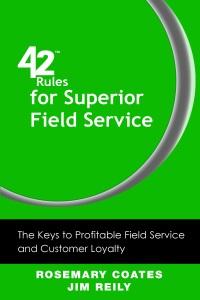I am proud to announce the publishing of my 3rd book, 42 Rules for Superior Field Service.
Writing a book is a daunting task. It may look easy and hundreds of thousands of people try it, but it is tougher than you think.
First you have to submit a book proposal to a publisher and hope your idea is good enough to be accepted. If your book proposal is accepted, you sign a contract and then your publisher or executive editor will work with you to determine a timeline and milestones for the book-writing process. Then you have to get busy and start researching and writing. If you prefer to outline your book first, this task must be accomplished early on.
If you are writing non-fiction, there is a lot of research to do. You must be able to write about a topic, plus back up your writing with facts and evidence, and perhaps some statistics. You may even conduct interviews with experts and surveys for data.
Armed with research, you begin the writing process. If you have a full-time job, this means being disciplined enough to write on some sort of schedule whethe r it’s weekends or nights or early mornings. Unfortunately, I find that after working all day, I am often too tired to write effectively at night. This means that my writing time stretches out longer than it should. Chapters that should take days to research and write often take weeks to finish.
r it’s weekends or nights or early mornings. Unfortunately, I find that after working all day, I am often too tired to write effectively at night. This means that my writing time stretches out longer than it should. Chapters that should take days to research and write often take weeks to finish.
Once the main body of writing is done, you must add “front matter” and “back matter” including an introduction, dedication, table of contents, appendices, contributors’ bios and an author’s bio. You must also obtain endorsements from colleagues or well-known people who can recommend your writing. Endorsements are printed on the back or inside flap of the book.
But don’t do a happy dance just yet…next comes the editing cycles. First there is executive editing, where your editor reviews the manuscript and gives feedback regarding the content. She makes suggestions about the flow and the way you have supported your information. When she’s done, you have a few re-write cycles that may take many weeks to complete.
After executive editing comes copy editing. In this stage, the grammar and style sheet police pick at every period, awkward phrase, tense agreement, capitalization, etc. The copy editor also checks facts and questions every detail that isn’t footnoted or attributed. When she’s done you have several more re-write and correction cycles.
Finally comes the lay-out process. Once again you edit the manuscript after it is laid out in book-form and again there are a few edit cycles. Once you are satisfied, the book goes to print. Only then you can do a happy dance!
Of course, once the book is published, the marketing cycles begin…